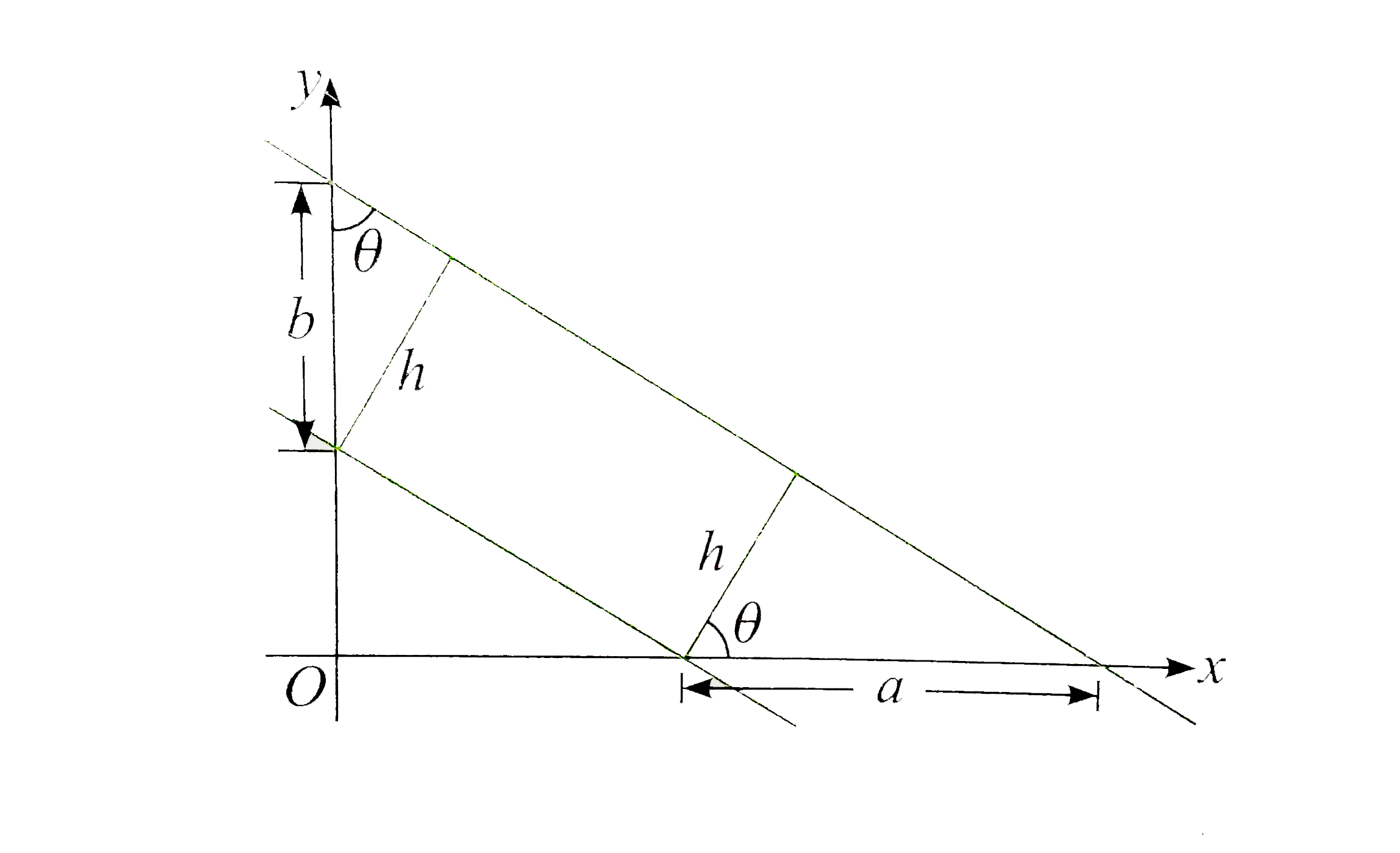Two parallel lines lying in the same quadrant make intercepts a and b on x and y axes, respectively, between them. The distance between the lines is (a) ab√a2+b2 (b) √a2+b2 (c) 1√a2+b2 (d) 1a2+1b2Solution in Tamil
√a2+b2
ab√a2+b2
1√a2+b2
1a2+1b2
The correct Answer is:B

From the figure
cosθ=ha and sinθ=hb
Squaring these and then adding, we get
1=h2a2+h2b2
∴h=ab√a2+b2
Topper's Solved these Questions
- STRAIGHT LINESBOOK - CENGAGECHAPTER - STRAIGHT LINESEXERCISE - Exercise (Multiple)
30 Videos
- STRAIGHT LINESBOOK - CENGAGECHAPTER - STRAIGHT LINESEXERCISE - Exercise (Comprehension)
27 Videos
- STRAIGHT LINESBOOK - CENGAGECHAPTER - STRAIGHT LINESEXERCISE - Exercise 2.6
5 Videos
- STRAIGHT LINEBOOK - CENGAGECHAPTER - STRAIGHT LINEEXERCISE - Multiple Correct Answers Type
8 Videos
- THEORY OF EQUATIONSBOOK - CENGAGECHAPTER - THEORY OF EQUATIONSEXERCISE - JEE Advanced Previous Year
9 Videos
Similar Questions
If P is a point (x,y) on the line y=−3x such that P and the point (3, 4) are on the opposite sides of the line 3x−4y=8, then x>815 (b) x>85 y<−85 (d) y<−815
View SolutionLet L be the line belonging to the family of straight lines (a+2b) x+(a-3b)y+a-8b =0, a, b ∈R, which is the farthest from the point (2, 2).
Area enclosed by the line L and the coordinate axes is
View SolutionIf aandb are two arbitrary constants, then prove that the straight line (a−2b)x+(a+3b)y+3a+4b=0 will pass through a fixed point. Find that point.
View SolutionThe point P(α,α+1) will lie inside the triangle whose vertices are A(0,3),B(−2,0) and C(6,1) if
View SolutionQ. Let p and q real number such that p≠0,p2≠q and p2≠−q. if α and β are non-zero complex number satisfying α+β=−p and α3+β3=q, then a quadratic equation having αβ and βα as its roots is
View SolutionIf the distance between the foci and the distance between the two directricies of the hyperbola x2a2−y2b2=1 are in the ratio 3:2, then b:a is (a)1:√2 (b) √3:√2 (c)1:2 (d) 2:1
View SolutionTwo parallel lines lying in the same quadrant make intercepts a and b on x and y axes, respectively, between them. The distance between the lines is (a) (ab)/sqrt(a^2+b^2) (b) sqrt(a^2+b^2) (c) 1/sqrt(a^2+b^2) (d) 1/a^2+1/b^2
View SolutionShow that the equation of the normal to the hyperbola (x^(2))/(a^(2))-(y^(2))/(b^(2))=1 at the point (a sqrt(2),b) is ax+b sqrt(2)y=(a^(2)+b^(2))sqrt(2)
View SolutionIf a=(sqrt(2)+1)/(sqrt(2)-1),b=(sqrt(2)-1)/(sqrt(2)+1), prove that a^(2)+ab+b^(2)=35
View SolutionTangents drawn from (2,0) to the circle x2+y2=1 touch the circle at AandB. Then (A) A≡(12,√32), B -= (-1/2, - sqrt(3)/2)(B)A-= (- 1/2, (-sqrt(3)/2),B≡(12,√32) (C) A≡(12,√32), B-= (1/2, - sqrt(3)/2) (D) A≡(12,−√32),B≡(12,√32)
View Solutionसिद्ध कीजिए की समान्तर सरल रेखाओं=
ax+by+c=0 और k(ax+by)+d=0 के बीच की दुरी (ck−d)÷k√a2+b2 है ।
View SolutionDistance of the points (a,b,c) for the y axis is
(a) √b2+c2(b)√c2+a2(c)√a2+b2(d)√a2+b2+c2
View SolutionIf the distance between the foci and the distance between the two directricies of the hyperbola x2a2−y2b2=1 are in the ratio 3:2, then b:a is (a)1:√2 (b) √3:√2 (c)1:2 (d) 2:1
View SolutionTwo parallel lines lying in the same quadrant make intercepts a and b on x and y axes, respectively, between them. The distance between the lines is (a) ab√a2+b2 (b) √a2+b2 (c) 1√a2+b2 (d) 1a2+1b2
View SolutionIf the distance between the foci and the distance between the two directricies of the hyperbola x2a2−y2b2=1 are in the ratio 3:2, then b:a is (a)1:√2 (b) √3:√2 (c)1:2 (d) 2:1
View Solution
